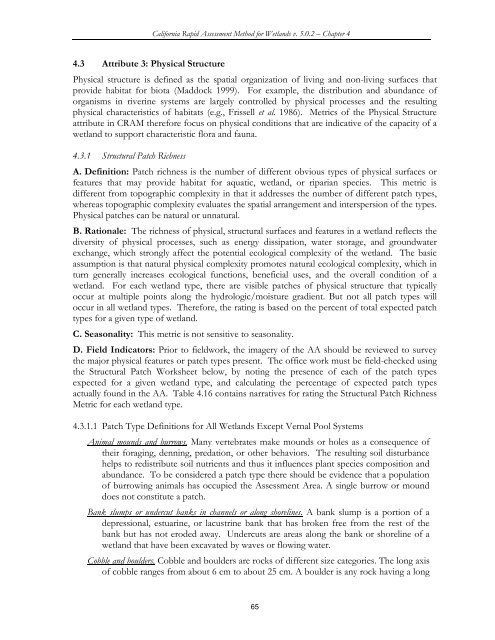(CRAM) For Wetlands User's Manual Version 5.0.2
(CRAM) For Wetlands User's Manual Version 5.0.2
(CRAM) For Wetlands User's Manual Version 5.0.2
You also want an ePaper? Increase the reach of your titles
YUMPU automatically turns print PDFs into web optimized ePapers that Google loves.
California Rapid Assessment Method for <strong>Wetlands</strong> v. <strong>5.0.2</strong> – Chapter 4<br />
4.3 Attribute 3: Physical Structure<br />
Physical structure is defined as the spatial organization of living and non-living surfaces that<br />
provide habitat for biota (Maddock 1999). <strong>For</strong> example, the distribution and abundance of<br />
organisms in riverine systems are largely controlled by physical processes and the resulting<br />
physical characteristics of habitats (e.g., Frissell et al. 1986). Metrics of the Physical Structure<br />
attribute in <strong>CRAM</strong> therefore focus on physical conditions that are indicative of the capacity of a<br />
wetland to support characteristic flora and fauna.<br />
4.3.1 Structural Patch Richness<br />
A. Definition: Patch richness is the number of different obvious types of physical surfaces or<br />
features that may provide habitat for aquatic, wetland, or riparian species. This metric is<br />
different from topographic complexity in that it addresses the number of different patch types,<br />
whereas topographic complexity evaluates the spatial arrangement and interspersion of the types.<br />
Physical patches can be natural or unnatural.<br />
B. Rationale: The richness of physical, structural surfaces and features in a wetland reflects the<br />
diversity of physical processes, such as energy dissipation, water storage, and groundwater<br />
exchange, which strongly affect the potential ecological complexity of the wetland. The basic<br />
assumption is that natural physical complexity promotes natural ecological complexity, which in<br />
turn generally increases ecological functions, beneficial uses, and the overall condition of a<br />
wetland. <strong>For</strong> each wetland type, there are visible patches of physical structure that typically<br />
occur at multiple points along the hydrologic/moisture gradient. But not all patch types will<br />
occur in all wetland types. Therefore, the rating is based on the percent of total expected patch<br />
types for a given type of wetland.<br />
C. Seasonality: This metric is not sensitive to seasonality.<br />
D. Field Indicators: Prior to fieldwork, the imagery of the AA should be reviewed to survey<br />
the major physical features or patch types present. The office work must be field-checked using<br />
the Structural Patch Worksheet below, by noting the presence of each of the patch types<br />
expected for a given wetland type, and calculating the percentage of expected patch types<br />
actually found in the AA. Table 4.16 contains narratives for rating the Structural Patch Richness<br />
Metric for each wetland type.<br />
4.3.1.1 Patch Type Definitions for All <strong>Wetlands</strong> Except Vernal Pool Systems<br />
Animal mounds and burrows. Many vertebrates make mounds or holes as a consequence of<br />
their foraging, denning, predation, or other behaviors. The resulting soil disturbance<br />
helps to redistribute soil nutrients and thus it influences plant species composition and<br />
abundance. To be considered a patch type there should be evidence that a population<br />
of burrowing animals has occupied the Assessment Area. A single burrow or mound<br />
does not constitute a patch.<br />
Bank slumps or undercut banks in channels or along shorelines. A bank slump is a portion of a<br />
depressional, estuarine, or lacustrine bank that has broken free from the rest of the<br />
bank but has not eroded away. Undercuts are areas along the bank or shoreline of a<br />
wetland that have been excavated by waves or flowing water.<br />
Cobble and boulders. Cobble and boulders are rocks of different size categories. The long axis<br />
of cobble ranges from about 6 cm to about 25 cm. A boulder is any rock having a long<br />
65















